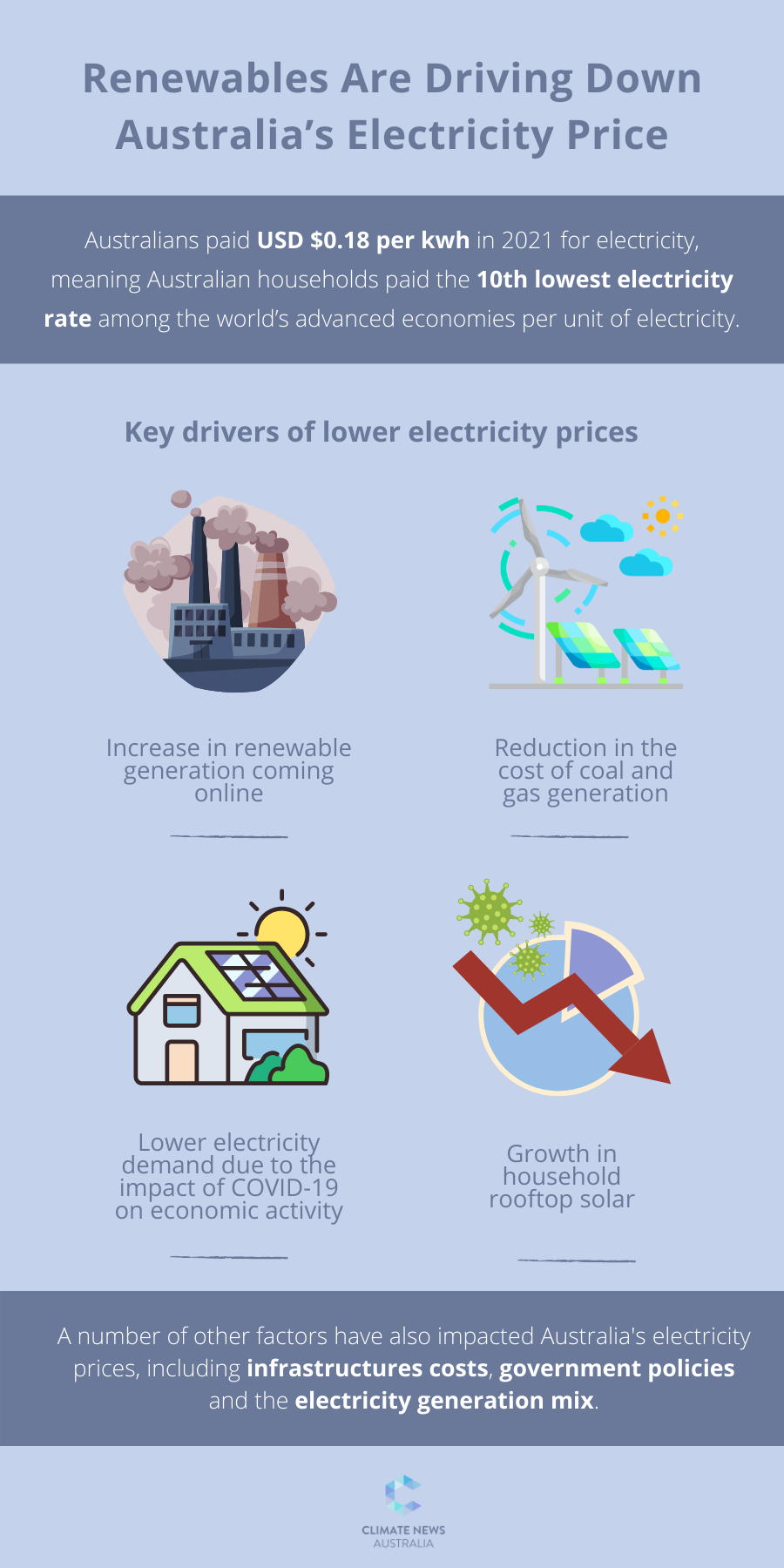Low-cost renewable energy is driving down the electricity price per kilowatt hour (kwh) in Australia, a new report has found. Australians paid USD $0.18 per kwh in 2021, meaning Australian households paid the tenth lowest electricity rate among the world’s advanced economies per unit of electricity. This is according to the Australian Energy Council (AEC), which represents 20 of the country’s largest electricity and downstream natural gas producers.
The AEC conducted an international comparison of household electricity prices, using the latest data from the Australian Competition and Consumer Commission (ACCC) in its latest National Electricity Market Review. The data was released at the end of 2021.
It found that Australian electricity prices were at their lowest in eight years. This means that Australia has the tenth lowest price of electricity per kwh of the 38 Organisation for Economic Co-operation and Development (OECD) countries. The average electricity price per kwh for OECD countries is USD $0.24 per kwh, compared to the Australian price of USD $0.18 per kwh.
Renewables are pushing down prices
An increase in renewable generation coming online is a key driver of lower electricity prices in Australia, the AEC said. Other factors include a reduction in the cost of coal and gas generation, as well as lower electricity demand due to the impact of COVID-19 on economic activity. Growth in household rooftop solar has also contributed to driving prices down.
The uptick in renewables and its impact on electricity prices per kwh has been seen in other countries too, the AEC said. However, a number of other factors also impact their electricity prices, including infrastructure costs, government policies and the electricity generation mix.
Germany, the Czech Republic and Poland had the highest household electricity bills in 2021. In Germany, more than half of the country’s electricity prices come from the government’s taxes, levies and surcharges. The AEC noted that Germany has an ambitious decarbonisation target for its electricity sector. While it is not the only factor influencing its power prices, Germany’s carbon dioxide tax has played a role. For every ton of carbon dioxide equivalent produced when heating with gas or oil, Germans have been required to pay €25 since the beginning of 2021. This tax includes using petrol and diesel vehicles.
The role of fossil fuels in electricity prices
European countries that are still reliant on coal and gas, like the Czech Republic, are experiencing high electricity prices too. This is because of the European Unions’ greenhouse gas emission allowances. This follows the European Commission’s plans to reduce emissions by 55 per cent by the end of the decade.
Coal is still the biggest source of energy worldwide, despite the vast amounts of carbon dioxide released when it is burned, driving global warming.
Polish electricity prices are also some of the highest among OECD countries due to Poland’s reliance on fossil fuels, like coal. Its electricity prices have increased higher than any other European Union country in 2020. Poland uses coal for about 70 per cent of its electricity generation. This in addition to what the European Union calls “inefficient production” and environmental policies have driven up prices.
Higher gas prices, low gas stocks and reduced demand in Asia are also pushing up European electricity prices, the AEC said.
The impact of hydro
Most of the countries joining Australia with the lowest prices of electricity globally used large amounts of hydroelectricity in 2021. This includes Canada, Iceland and Norway. About 60 per cent of Canada’s electricity comes from hydropower, while 13.5 per cent comes from nuclear. Canada sources 11.26 per cent of its electricity from gas. Meanwhile, Iceland sources 73 per cent of its electricity from hydropower, while the remainder comes from geothermal. Norway sources over 90 per cent of its electricity from hydropower.
South Korea also has some of the lowest residential electricity prices. But, this is for different reasons. It relies heavily on fossil fuels for electricity, but it keeps these prices down by heavily regulating electricity prices. However, increasing fuel costs from coal and gas, combined with moves by the Korean government to increase the profitability of its state electric company, mean rates will likely increase.

